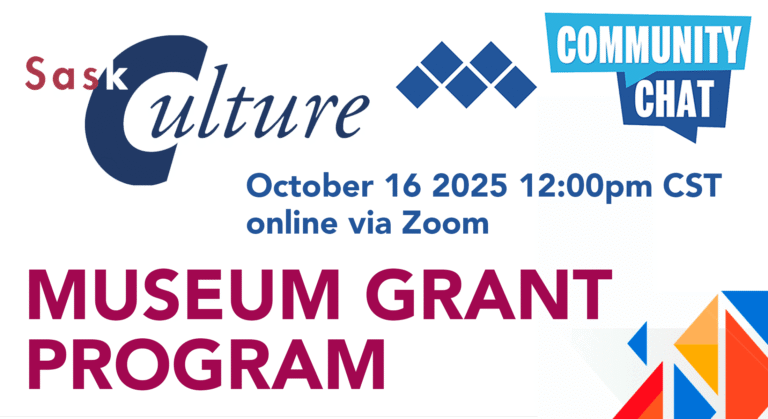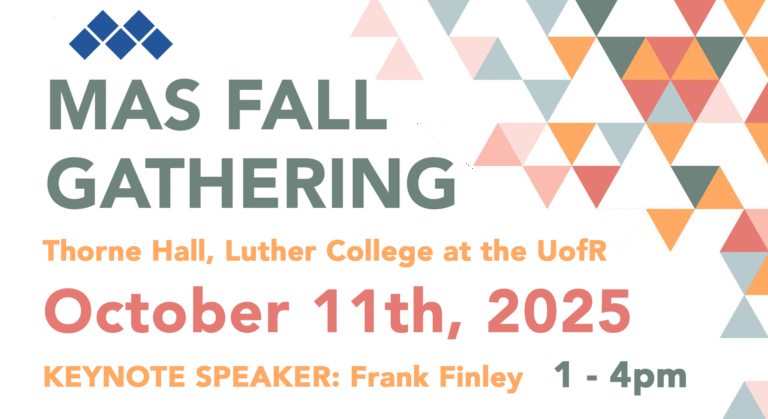Online Programming at the Moose Jaw Museum & Art Gallery
In conversation with Christy Schweiger, Education Coordinator, Moose Jaw Museum & Art Gallery.
The early days of COVID-19:
Before COVID, the bulk of Christy’s work was primarily with schools (doing gallery and museum tours and hands-on activities) and in-person public programming. That all came to an abrupt halt with the mandated closure of all non-essential services.
As the Educational Coordinator with the Moose Jaw Museum & Art Gallery (MJM&AG), Christy Schweiger had to redefine her work and role when in-person programming was put on indefinite hiatus. Prior to the COVID pandemic, Christy had also done a lot of work monitoring the MJM&AG’s website and social media (Facebook, Instagram, and YouTube).
In a typical year, Christy would see anywhere from 3,000 – 4,000 students every academic year. Despite being closed to the public, the museum & gallery were still operating, so it was essential to maintain some visible public presence. So, during this new found downtime, it was the perfect opportunity for Christy to up-date the MJM&AG’s website and put together daily posts for Facebook. It was an opportunity to try things out. She started putting together YouTube videos, focusing on things that were on display in the galleries (created a YouTube video outlining a hands-on activity to accompany the “Like a Falling Leaf” online exhibition) and walking tours around Moose Jaw (Community projects).
Making the move to online programming:
It was an exercise in creativity and adaptability. How can you create an engaging experience remotely? Taking advantage of social media and the technology at hand (an older cell phone with camera/recording capability), Christy set out.
This is not a “one and done” kind of venture. In the beginning, there was no indicator for when museums, galleries, and libraries would be allowed to resume public operations. With the shift to online, you are creating a new point of public interaction. This means that appropriate consideration must be given to continue to grow the community/audience with whom you are engaging. For the MJM&AG, this online engagement took the form of daily postings on social media, often themed (i.e., one month looking at different art movies, another looking at art books, etc.).
The trick is to draw attention to your social media, recognising it as an invaluable tool for engaging with online audiences.
There was a lot of playing around with technology. Multiple angles were often needed to be able to properly show steps for activities. Zoom would be set up on a laptop, and then a smartphone would be invited to provide overhead angles. Sometimes using a gimbal or tripod to stabilize the video or a homemade overhead phone mount (a box with a hole cut-out to give a hands-free overhead view).
The other major hurdle was with schools. School tours and programming were a staple. But as the pandemic really took hold, teachers were overwhelmed. There was no school programming in May. By June, Christy started to explore virtual classroom tours. Using her smartphone and connected to teachers via zoom, Microsoft Teams, or Google Classroom, she would take the classrooms on a real-time, live-streamed tour of the exhibitions.
Programs offered:
In the summer of 2020, the MJM&AG hosted online art camps. These camps were led by a summer student working remotely from Lethbridge while Christy would put together the art packages for participants to pick up locally.
Clay at Home took the pop-up clay classes that were offered in-person and moved them online. Kits are provided with all the materials participants will need, available for pick-up from the museum and gallery. Participants can then tune in to a live-stream for instructor guided learning and crafting or follow along with detailed written instructions.
In Conversation Series of artist talks, where the Director/Curator, Jennifer McRorie, speaks with artists about their practice and their exhibition at the MJM&AG.
Noon Hour – Slides invites participants to share their travel stories, revisiting past vacations. Participants for this program come from all over, well beyond just the local community.
Christy also used this time to develop programming for groups she had always wanted to engage with more, and for whom the lockdowns may have left inadvertently isolated; Group Homes and Seniors.
In the fall, in partnership with the University of Regina, Christy took part in a weekly, hour-long program to engage with seniors who remained shut-in. This program reached across the province and ran from September to June.
CREATEabilities is an online art program for adults with “special needs and learning differences”. This initiative requires participants to collect a kit that contains all the materials they need to complete the craft, and then they may attend a virtual session where the activities are completed with guided instruction.
What does the future of programming look like?
This past winter there were some in-person classes, but as case number of COVID-19 began to increase in the community, these programs were cancelled or postponed until the situation improved. Programs that could be delivered remotely were moved online.
This past winter and spring the MJM&AG offered more programming than any previous year.
While the future may still be uncertain, online programming has been a boon. We are now into the second year of the COVID pandemic and we have learned a lot. Although, we still may not know what to expect.
It is important to have online programming as an alternative to fall back upon. Sure, it can require a bit of extra work to plan your online programs. Prepping kits and writing instructions may not seem like anything unexpected for a programmer. However, instructions for online programming will need to be easy to follow and understand by the participants, detailing the step-by-step process of the activity, and will be helped along with appropriate visuals. Prepping kits for online delivery means more supplies; there will be no sharing of crayons, construction paper, or any other materials. And of course, the pandemic has had an unfortunate effect on the supply chain.
But the shift to online programming does not necessarily mean extra steps for everything. Some pre-existing programs may port easily over to online. For example, the MJM&AG used to host an in-person travel series. This program, Noon Hour – Slides, (http://www.mjmag.ca/noon-hour-slides) is still running, but online. A benefit to it now being online is that their audience for this program has grown well beyond just the local community. People from outside of Moose Jaw and some as far away as Ottawa. Also, participation numbers have remained fairly stable, without having to travel, numbers during the winter stayed consistent. Online programming offered a comfortable alternative to driving in winter conditions.
Overall, the MJM&AG saw fewer students than in previous years, but the interest in online programming came largely from those schools that have not previously attended in-person programs or tours. For years museums have noticed a decline in field trips, perhaps online programming can be a way of addressing the budgetary restraints schools are grappling with.
Website: http://www.mjmag.ca
Facebook: https://www.facebook.com/mjmag/
Instagram: https://www.instagram.com/mjmag.mj/
YouTube: https://www.youtube.com/channel/UCPoBcexOANccwfE0nB2YnDA
In summary:
- Online programming allows for real-time collaboration across the country;
- Online programming at the Moose Jaw Museum & Art Gallery utilised both live-stream and pre-recorded content to reach audiences;
- The management of social media has become a much more dominating presence. Social media has become an instrumental tool to connecting a museum to its community;
- Use what you have available to you – most smartphones have decent built-in cameras;
- Accessibility to Christy meant including people who had been shut-out/shut-in during the pandemic. To give them something to look forward to and help with people’s mental health.
The trick now is to keep these programs running.
Tip
Go a little bit at a time, take little steps. Do what you think is going to work, and test the waters. See what works and go with it.


